Last modified more than a year ago
Why are both ‘Competition’ and ‘Cooperation’ needed for CAD?

Program Director of SIP-adus.
In March 2021, the world’s first SAE level 3 vehicle was launched in Japan. Also, several SAE level 2 vehicles equipped high-precision 3D maps, developed within the SIP-adus program, were launched into the market. I am delighted that we could contribute these outcomes as program director of SIP-adus.
The Cross-ministerial Strategic Innovation Promotion Program, called SIP, is a program which strives to promote research and development in a seamless manner from the basic research stage to the final outcome with industry, academia and government cooperation (adus: Automated Driving for Universal Services).
Competition is an essential motivator for the development of automated driving by vehicle manufacturers. The competition motivates the industry to advance the technology, strive for efficient production processes and disseminate the technology to the consumers.
Then, why is “cooperation” needed for CAD? I presume there are 2 major reasons. First, since the regulatory regime surrounding passenger vehicles has grown historically over the course of the last 130 years, much of it is focused on “human” drivers. The introduction of automated driving technology requires a fundamental revision of this regulation on all levels. This revision should be based on a broad societal dialogue involving all relevant stakeholders. Second, the deployment of automated vehicles requires to the creation and distribution of various data such as high-precision 3D maps, and traffic environment information. Coordination between all involved stakeholders is necessary to generate these data more effectively and to distribute them safely. The CAD Knowledge Base plays a crucial role in facilitating the sharing of knowledge and data related to CAD.
Within the SIP-adus program in Japan, we have addressed these issues through enabling cooperation between industry, government and academia. This cooperation facilitated the revision of CAD-related regulation and the dissemination of high-precision 3D maps, as key elements to the deployment of ADAS systems and automated vehicles in Japan. However, we are just standing at the start line for the new era of automated driving, so it is crucial to accelerate these activities by international cooperation.
I believe that the purpose of developing automated driving technologies is to realize a society in which everyone can travel freely and safely. In order to achieve this, I hope that competition will continue to drive all of us to take automated driving to the next level, while successful cooperation will enable the needed framework to bring the technology to the consumers.
Seigo Kuzumaki,
Program Director of SIP-adus


